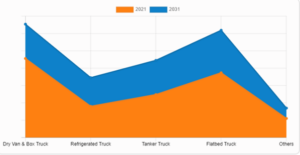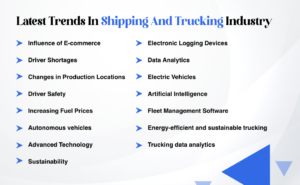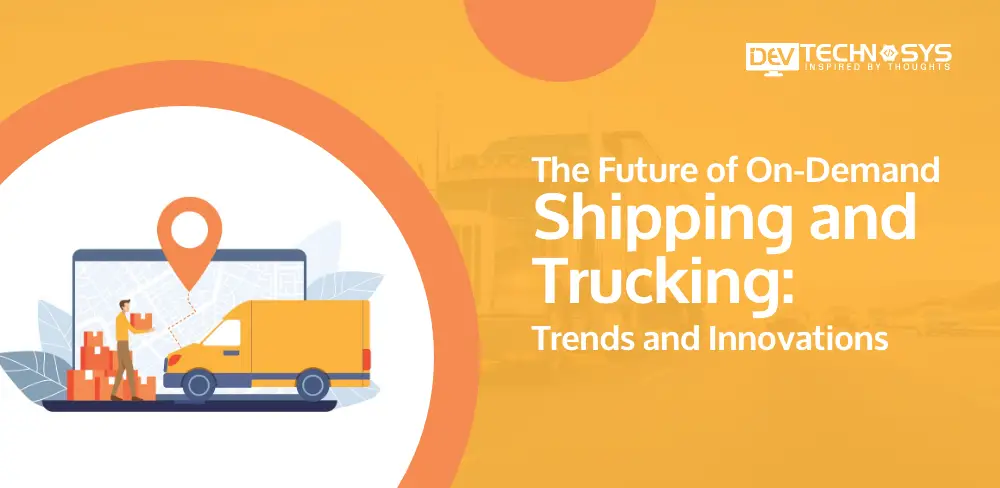“The shipping industry is the lifeblood of global trade, connecting businesses and consumers around the world.”
Peter Mandelson
Buckle up, fellow adventurers of the logistics realm, for we are about to embark on a thrilling journey into the future of on-demand shipping and trucking! In this era of rapid technological advancements and ever-evolving consumer demands, the traditional landscapes of logistics are being reshaped by groundbreaking trends and innovations.
Gone are the days of rigid schedules and cumbersome logistics processes. We now find ourselves in an exhilarating era of on-demand shipping, where speed, efficiency, and flexibility reign supreme. From autonomous vehicles revolutionizing the highways to smart warehouses orchestrating an intricate dance of deliveries, the stage is set for a logistics revolution like never before.
In this blog post, we will dive deep into the emerging trends and innovations that are propelling the on-demand shipping and trucking industry forward. Get ready to explore the realm of drones taking flight, blockchain securing the supply chain, artificial intelligence optimizing routes, and much more. The road ahead is teeming with possibilities, and it’s time to discover how these cutting-edge advancements are reshaping the future of on-demand shipping and trucking. So buckle up and come along for this thrilling voyage into the heart of logistics innovation!
Key Statistics of On-Demand Shipping and Trucking Industry

- The market for goods trucks worldwide, which was valued at $2,732 billion in 2021, is anticipated to increase to $4,457.4 billion by 2031, rising at a CAGR of 5.1% between 2022 and 2031.
- In 2020, 732.3 billion U.S. dollars in revenue was generated by the U.S. freight trucking industry, down from 791.7 billion U.S. dollars in the previous year.
- For a total value of products of $772 billion, trucks handled 67.7% of ground freight between the United States and Canada and 83.1% of commerce with Mexico. Employment in the trucking industry increased by 140,000 from the previous year to 7.95 million workers. This number includes 3.6 million professional drivers. The majority of carriers are small businesses, with 91.3% of fleets having six or fewer vehicles and 97.4% having 20 or fewer.
- Among all registered vehicles, commercial trucks make up 13.4%.
- Each gallon of diesel fuel cost $24.44 as of January 2019 thanks to federal fuel tax.
Latest Trends in On-Demand Shipping and Trucking Industry

1. Influence of E-commerce
The growth of online shopping is changing the trucking business. Trucking companies are in greater demand as online shopping continues to grow. On-Demand Shipping and Trucking companies are required to adapt to the rapid growth of the e-commerce industry in order to improve customer satisfaction.
The number of products being sent directly from manufacturers to consumers, rather than retail outlets, is increasing. This results in smaller shipments that can be difficult to manage. The smaller shipments have led to a greater demand for smaller trucks, and increased pressure on trucking firms to deliver packages faster.
2. Driver Shortages
Driver shortages are on the rise in the trucking industry. This issue is primarily influenced by a number of factors, such as a lack of available jobs, poor working conditions, an older workforce, and increased regulation. In order to keep drivers, trucking companies provide competitive pay, flexible scheduling, comfortable trucks, and other benefits. The transportation business may incur increased expenditures as a result.
3. Changes in Production Locations
Many of the biggest trucking businesses in the world have continued to operate out of the same facility for many years. Trucking companies are looking for new locations to run their production to meet current truck demand.
Trucking app development UAE companies that are larger relocate their operations in order to benefit from more favorable business conditions. These environments offer greater savings and a wider talent pool.
4. Driver Safety
Trucking is an extremely dangerous profession. For years, trucking companies have placed a greater value on efficiency and speed than driver safety. In response, a growing number of trucking firms are investing in technology that improves safety and improving standards. In the future, this focus on driver safety is likely to continue as the trucking sector faces increasing pressures to improve safety.
5. Increasing Fuel Prices
Due to its non-renewable nature, fuel costs have changed over time. This has had a significant long-term effect on transportation. A significant operational expenditure for the transportation sector is fuel. Shipping charges have gone up as a result of rising fuel prices.
The increased fuel prices result in a higher price for customers for On-Demand Shipping and Trucking services. The trucking industry also faces increased maintenance and repair costs due to higher fuel prices.
6. Autonomous vehicles
Self-driving cars, also known as autonomous vehicles, are the wave of the future for the trucking business. These vehicles have sensors and cameras to allow them to operate without a driver.
The majority of transportation companies are only in the beginning stages of testing autonomous cars. Autonomous vehicles will become more common as they become more advanced.
7. Advanced Technology
The trucking industry is becoming more technologically advanced. Trucking businesses track their cars and communicate with drivers using wireless technology. GPS Systems help drivers find the best routes to automated dispatching systems. This helps trucking companies manage their trucks better.
Telematics combines GPS with tracking and monitoring systems, a trend that is growing in the trucking sector. This On-Demand Shipping and Trucking technology allows trucking companies to track their vehicles live, improving truck management and dispatching.
Telematics can also be used to monitor driving behavior such as braking and speeding. Trucking businesses may utilize this information to improve the security and effectiveness of their operations.
8. Sustainability
Sustainability is becoming a bigger concern for the transportation sector. Environmental friendliness and carbon footprint reduction are priorities for trucking firms. Numerous companies are investing in on-demand app development which can be a great opportunity.
Its eco-friendly measures as the transportation sector become more aware of its effects on the environment. These initiatives may include investing in renewable energy and recycling, using fuel-efficient trucks, or investing in more efficient trucks. Due to the increasing popularity of electric trucks, as well as the high price of fuel, there is an increased interest in alternative fuels such as natural gas, hydrogen, and propane.
These alternative fuels are more efficient and cleaner than diesel.
9. Electronic Logging Devices
The majority of companies now use electronic logs for the efficient management of their trucks. E-logs, or electronic logbooks, record a variety of information including the hours worked by a driver, miles traveled, route, breaks, and driving conditions.
These data are recorded more precisely and specifically than paper-based solutions. This allows companies to monitor drivers’ activities, and to respond to any potential problems. Thus if you want to develop an electronic logging device for your business, then you should hire dedicated developers.
10. Data Analytics
Many on-demand trucking companies are now incorporating data analytics into their business. Businesses may utilize data analytics to forecast maintenance cycles, spot patterns in consumer demand, and recommend preferable dispatch times.
Trucking companies can also use analytics to improve the accuracy of their delivery estimates by gaining insight into their truck’s performance. Data analysis can help trucking companies identify areas for improvement and to adjust their strategies in order to be more profitable.
11. Electric Vehicles
Electric vehicles are not new. However, when we consider fleets, their use is about to explode. Some trucks are designed for long distances and are difficult to convert.
Electric truck models will develop at a very low pace. Electric vehicles will be used in the future of trucking, but for long distances, a larger battery is needed. The current electric solutions cannot meet this need. Volkswagen uses solid-state batteries to deliver the best results while reducing the cost of electric cars.
The On-Demand Shipping and Trucking industry has been greatly impacted by Electric models and electric vehicle manufacturers are on the radar of fleets operating in urban and rural areas. Manufacturers are now putting money to build on-demand trucking apps to quickly meet the demand.
12. Artificial Intelligence
It is normal to pay attention to advanced technology in trucking, as the electric and autonomous solutions are a bit out of reach. Automation is essential to determine the routes, allocate drivers and loads, and assign loads.
Software for fleet management may be used to regulate and improve a variety of variables, including asset tracking, driver monitoring, and preventative maintenance. The usage of AI in transportation is shortly to come.
13. Fleet Management Software
The time of simple software tools has passed and we are now developing new, more advanced tools. These tools aim to bring innovation in many aspects of the industry. Artificial intelligence (AI) and machine learning will be able to be integrated thanks to the transportation technology platform. In order to support the development and innovation of trucking firms, it will also maintain the database and create the best trucking app Dubai.
Incorporating cutting-edge technology facilitates the growth of a company. Customers get access to truck position tracking and driver and location data. You will be able to manage data and workflows and have countless options thanks to fleet management software.
14. Energy-efficient and sustainable trucking
The transport industry has come under heavy criticism for its role in contributing to one-fifth of global carbon dioxide emissions. As a result of this, many On-Demand Shipping and Trucking companies, such as those in the trucking sector, are now going green to combat the growing threat of global climate change.
The transport sector is making efforts to lessen its carbon footprint. There are various approaches to implementing sustainable, energy-efficient transportation. One of the better examples is electric automobiles. They have changed the perception that trucks cannot be sustainable.
Trucking companies are also looking at low-emission vehicles that could easily replace diesel trucks. Diesel trucks are the main source of pollution. The alternatives are therefore more environmentally friendly in the long term.

15. Trucking data analytics
Trucking businesses use Big-data analytics to design their routes and estimate journey times. Here are a few on-demand shipping apps UAE for data analytics.
The analyses are based on data from different sources, such as vehicles and fleet management software. They also include maintenance, financial management, and other areas of business that can help improve the system.
IoT Devices, and 5G Network Infrastructure, will enable energy-efficient systems and reduce costs. In the transportation industry, 5G will allow end-to-end communication across multiple communication methods. Here is the future of trucking.
Technologies Changing the On-Demand Shipping and Trucking

You can see the slowdown of the economy by competition and rising trucking costs. The trucking sector has already begun to use advanced technology for business improvements. It is an exciting time for the On-Demand Shipping and Trucking sector as technology will continue to advance at a rapid pace.
1. Aerodynamics
The Airplanes have a reason for being rounded and not having a squared front. The resistance will increase as the wind speed increases. The Aerodynamics of trucks and trailers can increase fuel efficiency while transporting. In the coming years, there will be many new aerodynamic technologies like wheel covers and underbody protection that can improve mileage.
2. Powertrain
Powertrains with the latest technology and equipped with advanced features are expected to reduce shipping costs across the nation. Engines are being downsized to reduce weight and increase efficiency. Turbo charging has also been improved to deliver powerful acceleration and reduce fuel consumption on highways. The business will test Electric and hybrid powertrains over time to determine if they are an efficient means of transport.
3. Telematics
The new telematics technology is following the footsteps of GPS, which helped to improve the trucking industry in the past two decades. With the use of route planning and scheduling systems as well as vehicle-to-vehicle communications, the On-Demand Shipping and Trucking industry will become smarter, safer, and more effective. We can expect that the industry will converge as all manufacturers are working on similar systems.
4. Safety
It can reduce accidents by a large number with its added safety and security features. The reduction of accidents has a positive impact on truckers, companies that provide trucking services, and the public. Lower insurance rates and vehicle maintenance expenses will also follow from fewer collisions. Trucks are safer thanks to the latest braking and lane-departure features. This will increase industry confidence.
5. The Onboard Diagnostics
Trucking is pushing for real-time technologies. You will soon see embedded diagnostics in the engine, the fleet management system, and the transmission of the vehicles. The effectiveness and performance of the vehicles will be constantly under the fleet managers’ observation. By doing so, you can avoid costly problems, and servicing and can schedule maintenance.
6. Driver Comfort
Several studies have shown that a driver who is comfortable will not suffer the effects of fatigue on the highway and be more alert at work. Businesses develop technology to improve the comfort of truck drivers and ensure they reach their destinations safely. You can adjust the Seats to reduce pressure points and have improved ergonomics. They also feature better steering, information systems, and increased control.
7. Autonomous Trucking
Truck manufacturers are testing autonomous technologies at the same time as we hear a lot about autonomous passenger cars. It is only a question of time until the driver releases the truck.
Here are some of these technologies that have made their mark on the trucking industry. We will continue to make progress and are committed to being proactive, intelligent, and encouraging in the implementation of new trucking technology.
Conclusion
Prepare yourself for the next revolution in shipping and trucks! On-Demand Shipping and Trucking will be awash with new trends and innovations in the future. The industry will soar with new technologies such as autonomous vehicles, drone deliveries, and blockchain-based tracking. Partner with a modern hire transportation software development services provider to ensure seamless and efficient transportation for years to come. Prepare to see the future in action!
FAQ
How has Technology Transformed the Trucking Industry in Recent Years?
Fewer accidents can reduce insurance costs and repair costs. Truck driving is safer with lane departure alerts and advances in braking.
How to Build Logistics Apps ?
To build logistics apps, follow these steps:
- Define your app’s purpose and features.
- Choose a development platform.
- Design a user-friendly interface.
- Develop the app using suitable programming languages and frameworks.
- Integrate APIs for real-time tracking, payments, and notifications.
- Test thoroughly and launch your logistics app.
How Much Does Pickup Delivery App Development Cost?
The pickup delivery app development cost varies based on several factors, including complexity, features, platforms, and development team rates. On average, it can range from $8,000 to $25,000 or more. It’s best to consult with a custom mobile app development company for accurate cost estimates tailored to your specific requirements.
How Can Automation be Implemented in the Logistics Industry?
Automation can be implemented in many ways – smart robotics, AI-powered delivery management software, and self-driving cars. Robotics can help with sorting, picking, and packing processes. Autonomous trucks will deliver goods more efficiently. Adding AI and ML to your systems can help with route planning, maintenance forecasting, and demand forecasting.
How Can the Internet of Things be Used to Improve Logistics?
Logistics organizations can make better judgments thanks to IoT devices that connect and gather real-time data. You can use IoT devices to improve maintenance schedules, optimize routes and reduce fuel costs. This will be beneficial in warehouse operations, as it can monitor temperature and other conditions for resource efficiency and worker’s safety.




















